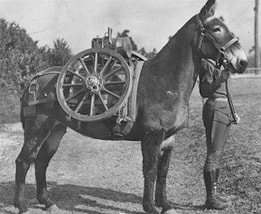 The youngest reenactor at Glorieta. His father told me that this was his first encampment. The youngest reenactor at Glorieta. His father told me that this was his first encampment.Last weekend, the 160th anniversary of the Battle of Glorieta Pass was observed. I drove up to Pecos National Historic Site on Saturday morning to witness the observation. The weekend was pretty low key. A group of Union reenactors attended. They put up tents and spend the night. No Confederate reenactors were there. I was walking up from the parking lot when I heard gun fire. The reenactors gave some black powder displays, but there was no reenactment of the battle. The one and only artillery piece, a mountain howitzer, was going to be fired at noon, but I didn't stay around long enough to hear it.  Fort Union's Mountain Howitzer Fort Union's Mountain HowitzerThe New Mexico Artillery Company has several cannons they bring to reenactments. However, the Park Service demands that all cannons brought on to their property are accurate reproductions. Most of the ones used by the Artillery Company have smaller bores than authentic Civil War cannons. Smaller bores are cheaper to fire. The one present this past weekend was a mountain howitzer which was brought down from Fort Union for the day. This replica, like the actual gun, was made of bronze and had a smooth bore. It could fire an explosive shell, a cannon ball, or canister 1,005 yards.  A mule carrying cannon wheels. A mule carrying cannon wheels.The mountain howitzer was first created in 1837. The United States Army used it during the Mexican–American War (1847–1848), the American Indian Wars, and during the American Civil War, (1861–1865). It was used primarily in the more rugged parts of the West. It was designed to be lightweight and very portable, even in difficult, mountainous terrain. The carriage design allowed it to be broken down into three loads, that could then be loaded onto a pack animal for transport where other guns could not go. When broken down, the tube could be carried by one horse or mule, the carriage and wheels by another, and ammunition on a third. This made it well suited for Indian fighting and mountain warfare. .Although mountain howitzers provided artillery support for mobile military forces ion the move through rugged country, their shorter range made them unsuitable for dueling with other heavier field artillery weapons. They were replaced by other guns by the 1870s.  Author Jennifer Bohnhoff writes historical fiction for middle grade readers and adults. Where Duty Calls, the first in a trilogy of novels set in New Mexico during the Civil War, will be published by Kinkajou Press, a division of Artemesia Publishing, in June 2022 and is available for preorder from Amazon or Bookshop. For class sets or other bulk orders, contact Artemesia Publishing. A teacher's guide will be available this summer from the publisher. |





No comments:
Post a Comment